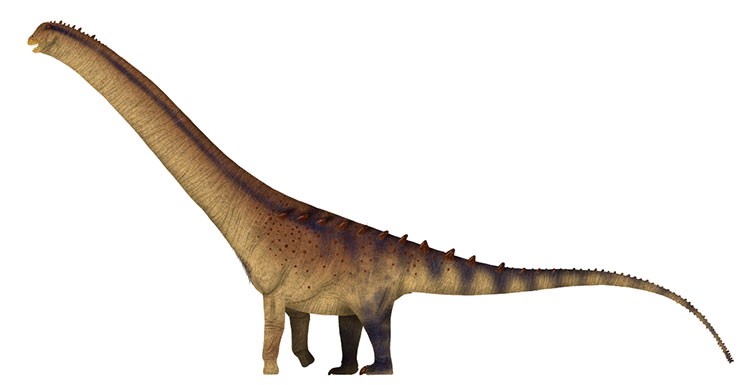Dinosaurs remain the largest land animals to ever walk the Earth. Among them, titanosaurs like Puertasaurus, Patagotitan, and Argentinosaurus reigned supreme, dwarfing even the blue whale in length and potentially weighing as much as ten or more elephants. But what allowed these creatures to reach such colossal sizes? Let’s delve into the fascinating world of dinosaur gigantism.
Titanosaur Titans: The Heavyweight Champions of the Dinosaur World
While iconic dinosaurs like Spinosaurus and T. rex were formidable predators, they were dwarfed by the true giants: the sauropods. And among sauropods, the titanosaurs were the undisputed champions of size. Patagotitan, for instance, was about 50% longer and a staggering four times heavier than the already massive Diplodocus.
Patagotitan measured approximately 37.5 meters in length and weighed an estimated 57 tonnes. © Sphenaphinae (CC BY-SA 4.0) via Wikimedia Commons
While blue whales hold the title of the largest animals ever, they benefit from the buoyancy of water. Dinosaurs, on the other hand, had to support their immense weight on land, a feat requiring unique adaptations. Titanosaurs like Puertasaurus, Patagotitan, and Argentinosaurus represent the pinnacle of terrestrial size in Earth’s history.
Dwarving Land Mammals: A Comparison of Giants
Compared to modern giants, even the largest land animal today, the African savanna elephant, pales in comparison to the titanosaurs. While elephants typically weigh five to seven tonnes, the largest titanosaurs were about ten times heavier. Even the extinct Paraceratherium, a massive rhinoceros relative and arguably the largest known land mammal, weighed up to 20 tonnes, still significantly less than the largest sauropods. This highlights the unparalleled size achieved by these dinosaurs.
Not all dinosaurs were giants. Compsognathus, for example, was only about 2.5 times the length of an average human footprint. © Dotted Yeti/ Shutterstock
The Secrets of Sauropod Size: A Combination of Factors
The extraordinary size of dinosaurs wasn’t due to a single factor, but rather a combination of evolutionary advantages:
Body Shape Built for Bulk
Dinosaurs possessed an upright stance, with legs positioned directly beneath their bodies, providing excellent support for their massive weight. This pillar-like structure was more efficient for weight-bearing than the sprawling stance of reptiles like lizards and crocodiles.
An upright stance allowed dinosaurs to support more weight. Adapted from an image by Fred the Oyster, via Wikimedia Commons, licensed under CC BY-SA 4.0.
Sauropods further enhanced stability with unique adaptations: less mobile but stronger wrists and ankles, huge padded feet for weight distribution, and exceptionally wide hips for stability and a larger stomach capacity.
Long Necks for Efficient Feeding
Sauropods’ long necks allowed them to access a wide range of vegetation without moving their large bodies, conserving energy. They could reach high into trees, accessing food unavailable to other herbivores. This efficient feeding strategy was crucial for sustaining their immense size.
Long necks enabled sauropods to access a wide range of food with minimal effort. © Catmando/ Shutterstock
Their small heads and lack of chewing teeth further contributed to neck length by reducing weight.
Lightweight Bones and Efficient Respiration
Unlike mammals, sauropods and theropods had hollow, air-filled bones, significantly reducing their weight without compromising strength. These air sacs also played a crucial role in a highly efficient bird-like respiratory system, providing a constant flow of oxygen, even during exhalation. This efficient breathing was essential for powering their large bodies and sustaining long necks.
Mamenchisaurus sinocanadorum had a neck measuring 15 meters long. © Elenarts/ Shutterstock
A Low-Energy Lifestyle
Sauropods had a slow metabolism, requiring less food relative to their size compared to mammals. Their large stomachs allowed for thorough digestion, extracting maximum nutrients from plants. They also lost less energy as heat due to a lower surface area-to-volume ratio.
Like dinosaurs, geese have efficient respiratory systems, enabling them to fly at high altitudes. © Imran Shah (CC BY-SA 2.0), via Flickr
The Advantages and Disadvantages of Being Big
Large size offered protection from predators, access to unique food sources, and resilience during droughts. However, it also meant increased vulnerability to food shortages and overheating. Sauropods evolved adaptations to mitigate these risks, such as efficient heat loss mechanisms through their long necks and tails.
Large size offered protection but also presented challenges. © Catmando/ Shutterstock
Could Giants Rise Again?
While it’s theoretically possible for land animals to evolve to gigantic sizes, it’s unlikely they will reach the scale of sauropods. The unique combination of features that enabled sauropod gigantism is not present in any modern animal. The reign of the titanosaurs remains a unique chapter in Earth’s history. Their story serves as a reminder of the incredible diversity and adaptability of life on our planet.
